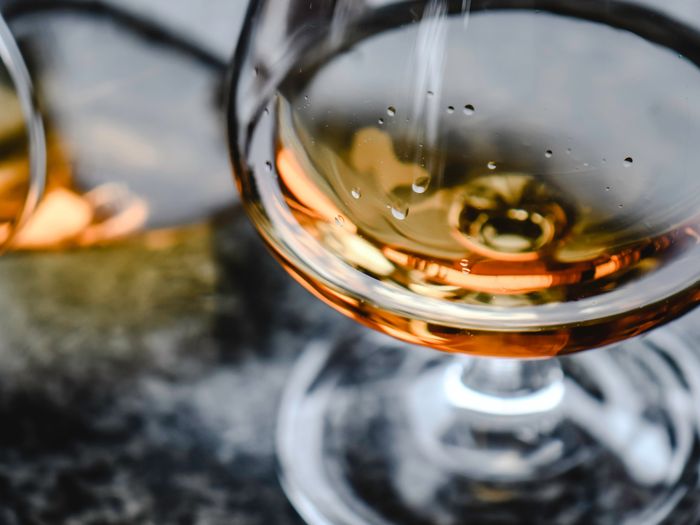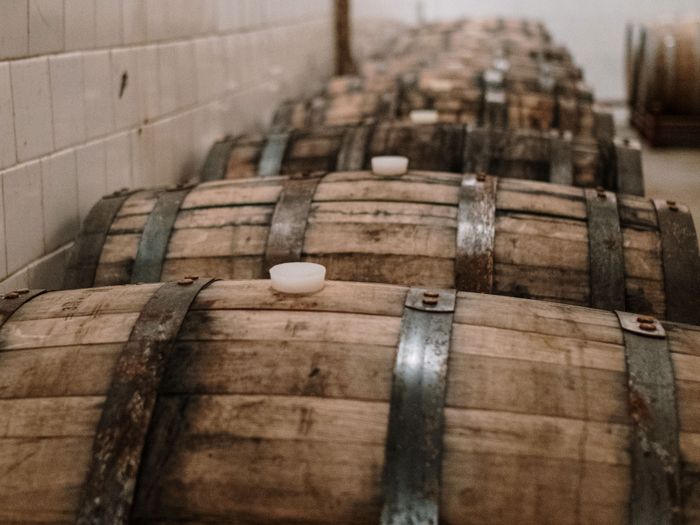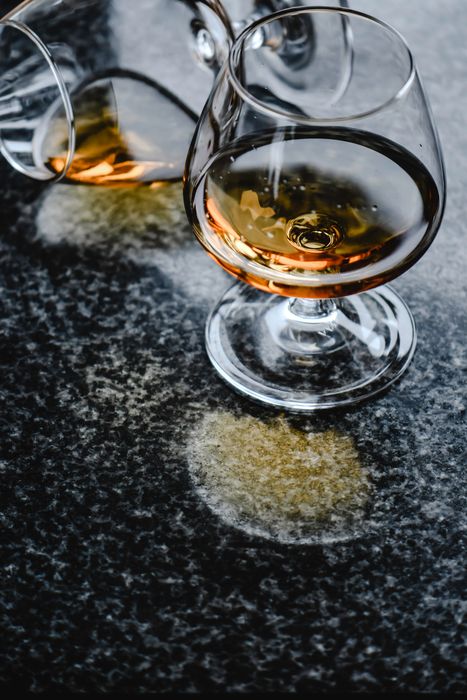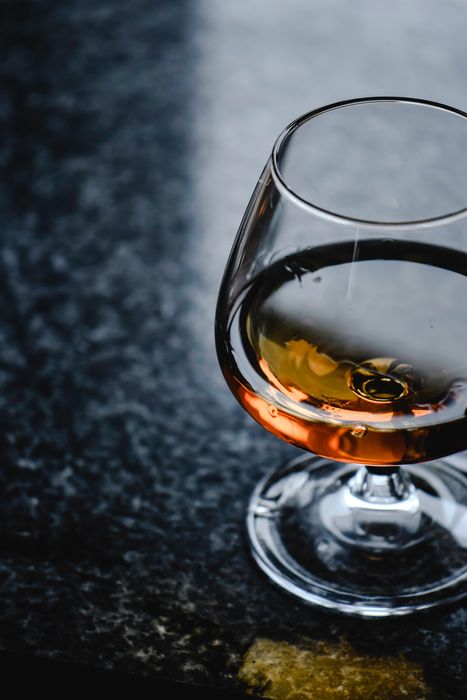
The color of rum comes in a very rich range, from total transparency to the deepest black. However, when they come out of the still, rums are invariably translucent, without exception. It is in contact with wood that they later gain different shades, more or less sustained, more or less rich.
White rums
White rums are therefore in principle distillates that have not been aged. They have been rested in inert containers, such as stainless steel vats, glass demijohns , or sometimes even terracotta containers. When they have been stored in large wooden vats of several thousand liters, they may have a slight tint. This is very subtle, because in these huge containers, the contact surface of the wood is minimal compared to the total volume.
First exception to the rule: barrel-aged white rums. How is this possible? The great Cuban classic, the Havana Club 3 years old , is a perfect example of this category. After aging for 3 years in American oak barrels, it acquired an amber hue that was subsequently removed using activated carbon filtration. It thus retains the aromas of the old rum, while simply being coated with a very light straw color.
The interest of this practice is mainly visual, in the context of use in cocktails. Rum can be mixed in a Daïquiri for example, and thus offer both a luminous color and an enriched range of aromas.
For a long time, rum was classified according to its use by bartenders. There were mainly 3 main categories: white, amber and brown rums. While this classification is interesting in mixology, it does not reflect the value or quality of a rum. With the rise in the range of rum and its affirmation as a tasting spirit, we are now trying to free ourselves from this classification. We are talking more about style or manufacturing method.
Old rums
As we have seen, the color of rum is the result of an exchange between the wood of the barrel and the liquid. It is the tannins, soluble in water and alcohol, which migrate from the wood to the liquid during aging. Once again, appearances are deceptive. One might think that the darker the rum, the more time it has spent in the barrel, and therefore the better its quality. It turns out that the reality is much more complex.
The influence of cooperage work
The choice of barrel is one of the fundamental parameters considered by the cellar master when imagining a future vintage. This begins with the different types of wood (most often oak). American oak , for example, tends to give amber hues that over time go as far as mahogany, with red nuances. French oak, for its part, typically brings more or less deep golden colors.
The size of the barrel is also a variable that can be played with. The smaller it is, the lower the wood/liquid ratio. That is to say, in a small barrel, the surface area of rum in contact with the liquid is greater. We have a greater proportion of tannins extracted in the rum, therefore more color.
Tannins are not the only ones responsible for color. The preparation of the barrel before aging also has a very important impact. By the way, if you want to know more in this area, go to our article dedicated to cooperage .
During assembly, the barrels are heated to form a blend. This also caramelizes the sugars contained in the wood. This caramelization can be further enhanced by carrying out a more intense aromatic heat, also called bousinage. The Maillard reaction, which causes caramelization, produces both aromas (roasting, vanilla, spices, etc.) and a brown color, which is also transmitted to the liquid. Naturally, the more the barrel is heated, the more color it gives to the rum.
Used barrels
The hue of rum can also come from the alcohol that the barrel previously contained. The use of second-hand barrels is widespread, and even the majority. Ex-bourbon barrels, but also ex-cognac or ex-sherry barrels are very common. Although the barrels are emptied before being used again, they have absorbed a significant amount of the previous alcohol. This also enters into the wood/rum exchanges during aging. For example, sherry, port, or red wine barrels provide a deep hue that is far from the usual amber range. The darkness of the ruby or pinkish shades that they provide is even more pronounced with the oxidation that develops during maturation.
The duration of use of the barrel
In this context, the age of the barrel is also crucial. When the barrel is new, it still contains a large quantity of tannins, even if a good part of them has already been evacuated during preparation in the cooperage, and even earlier, in the stave mill (see our article on Tonnellerie Allary ). In a few months, it can already give a lot of color. This contribution also depends on the degree of barreling. The higher the alcohol content, the greater the extraction of tannins. This is a new variable among the dozens of decisions that the cellar master makes throughout production.
Then, as other alcohols or rum are successively passed through, the tannins become rarer. It is colloquially said that the barrel is increasingly "rinsed". The barrel is then ready for longer periods of maturation where the rum oxygenates and slowly changes instead of actively drawing on the compounds from the wood. If the rum does the majority of its aging in a 2nd, 3rd or even 4th fill barrel, it can then spend 20 years there and only have a slight straw color. Conversely, a rum aged for 2 years in a new barrel can be practically black and opaque.
The place of aging
Finally, the place where the rum ages also has a decisive impact. Heat plays a role in the solubility of tannins, and therefore in their extraction by water and alcohol. Let us recall in passing that a rum with 40% alcohol is also composed of nearly 60% water. The rum therefore tends to be darker, more quickly, when it ages in a tropical climate. This is also the case when the barrel is placed at the top of the cellar, under the roofs. Montebello rums, for example, maximize this phenomenon by placing their barrels in old transport containers left under the Guadeloupe sun.
Dyes
The last person responsible for the color of the rum, which does not come from the barrel this time: the coloring. Right away, we can consider that this amounts to cheating, but it is possible to qualify this judgment. We have several cases on this subject, for different uses:
Enhance the color of the rum
Despite efforts to inform the public (in which we are modestly participating with this article), there is a bias among consumers who believe that the value of a rum lies in its color. It is therefore a question of perceived quality, to which producers sometimes respond by "boosting" the color of their rum using colorings.
The most commonly used colouring agent is e150a. It is a highly concentrated caramel (bitter and not sweet) of which a light touch is enough to colour hundreds of litres. We can also use (although it is less admitted) a traditional method from the world of cognac : woody flavourings. These concentrates are made by boiling wood and reducing the juice thus obtained. Just like the wood chips added to the barrels, this practice also and above all has a flavouring objective.
To ensure consistency and continuity
When the cellar master makes a blend of several barrels (see our article on the art of aging rums ), you should know that each of them is unique and that none of them gives the same color. So imagine having to make the same blend, with the same aromatic profile, the same color, year after year. It is a real feat. The aromatic profiles evolve each year according to an infinite number of criteria. We can easily imagine that the same is true for the color. In order not to have bottles of the same product that would have different shades on the same shelf, an adjustment is authorized in order to smooth out production and offer consistency to consumers. This adjustment is regulated, as in the AOC Martinique which limits it to 2% obscuration.
Obscuration is the difference between the actual alcoholic strength by volume (the alcohol content, the proportions of alcohol/water after distillation) indicated on the label, and the gross alcoholic strength by volume, measured by studying the density of the rum. When a difference is observed, it is because something changes the density of the liquid and disrupts the measurement of the alcohol content.
More and more brands are no longer using coloring, especially for their limited series. Obviously, for unique barrels , small vintages or for specialized products aimed at connoisseurs, this coloring is not necessary. Independent bottlers also rarely use it, because they increasingly advocate transparency and public education. They also work with small series that do not require smoothing.
The Dark Rums
Dark Rums or Navy Rums are a category apart, where coloring is essential. The addition of caramel or molasses is part of their identity. The cocktails dedicated to them require their color to be extremely dark and pronounced.
For spirits lovers like us, the natural color is more interesting. It tells us something about the history of our rum. It is conducive to study and comparisons, and allows us to understand through tasting the impact that the age of the cask used, the alcohol previously contained, the difference between continental or tropical aging can have on the same rum, in order to refine our preferences on objective bases, with full knowledge of the facts.
It is fascinating to understand and appreciate the fact that the color is the result of multiple choices made in the orientation of the aromatic profile, whether to give more voice to the distillate, the wood, the age, the environment, but that in any case it says nothing about the intrinsic quality of what we drink.




Very very interesting
Thank you for publishing this enriching data. To consumers and producers the world of rum is revealed on rhumattitude…
Thank you very much for this feedback Marro
Good morning,
I enjoy all your readings!
Question:
Is it possible to make a certain amount of boiling to obtain a vanilla aroma?
I notice this taste more and more when tasting wine!
Which personally bothers me, but for the rum, that's interesting!
Thank you for your reply,
Laurence
Yes of course you can.
You should know that the barrels are often already charred if you buy them. This is the case for example with the Allary barrels that we sell.